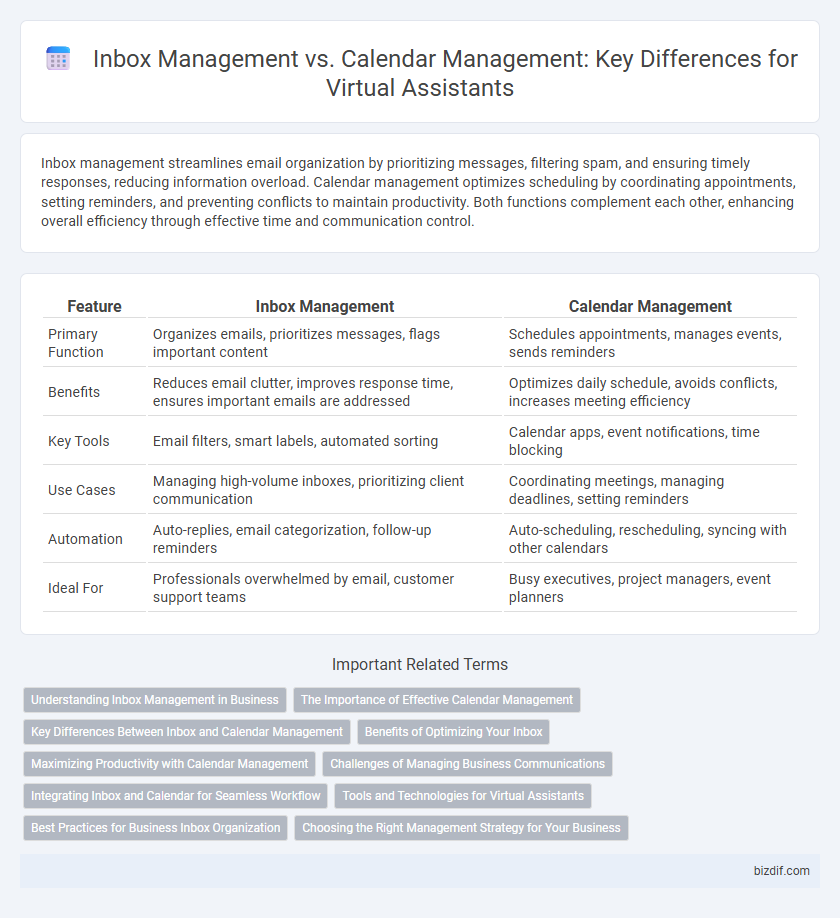Inbox management streamlines email organization by prioritizing messages, filtering spam, and ensuring timely responses, reducing information overload. Calendar management optimizes scheduling by coordinating appointments, setting reminders, and preventing conflicts to maintain productivity. Both functions complement each other, enhancing overall efficiency through effective time and communication control.
Table of Comparison
| Feature | Inbox Management | Calendar Management |
|---|---|---|
| Primary Function | Organizes emails, prioritizes messages, flags important content | Schedules appointments, manages events, sends reminders |
| Benefits | Reduces email clutter, improves response time, ensures important emails are addressed | Optimizes daily schedule, avoids conflicts, increases meeting efficiency |
| Key Tools | Email filters, smart labels, automated sorting | Calendar apps, event notifications, time blocking |
| Use Cases | Managing high-volume inboxes, prioritizing client communication | Coordinating meetings, managing deadlines, setting reminders |
| Automation | Auto-replies, email categorization, follow-up reminders | Auto-scheduling, rescheduling, syncing with other calendars |
| Ideal For | Professionals overwhelmed by email, customer support teams | Busy executives, project managers, event planners |
Understanding Inbox Management in Business
Inbox management in business involves organizing, prioritizing, and responding to emails efficiently to ensure timely communication and prevent important messages from being overlooked. Effective inbox management boosts productivity by reducing email clutter and allowing teams to focus on high-priority tasks. Virtual assistants skilled in inbox management use tools like filters, labels, and automated responses to streamline workflow and enhance organizational efficiency.
The Importance of Effective Calendar Management
Effective calendar management ensures optimal time allocation and boosts productivity by preventing scheduling conflicts and overbooking. Unlike inbox management, which organizes incoming communication, calendar management directly influences daily workflow by prioritizing tasks and appointments. This strategic approach is crucial for virtual assistants to streamline operations and maintain a balanced, efficient schedule.
Key Differences Between Inbox and Calendar Management
Inbox management focuses on organizing, prioritizing, and responding to emails efficiently to maintain clear communication and reduce clutter. Calendar management involves scheduling, tracking appointments, and managing time blocks to optimize productivity and avoid conflicts. The key difference lies in inbox management dealing primarily with messages and correspondence, while calendar management centers on time allocation and event coordination.
Benefits of Optimizing Your Inbox
Optimizing your inbox enhances productivity by reducing email clutter and prioritizing important messages, ensuring timely responses and minimizing missed opportunities. Efficient inbox management improves workflow by categorizing and filtering emails, allowing faster retrieval and better focus on critical tasks. This results in decreased stress and increased control over daily communications compared to calendar management, which primarily focuses on scheduling rather than message organization.
Maximizing Productivity with Calendar Management
Calendar management maximizes productivity by organizing time around priority tasks and deadlines, reducing the risk of overbooking or missed appointments. Unlike inbox management, which handles communication flow, calendar management ensures proactive scheduling and efficient time allocation throughout the day. Leveraging calendar tools with automated reminders and synchronization across devices enhances focus and task completion rates.
Challenges of Managing Business Communications
Inbox management demands constant prioritization of high-volume emails, filtering important messages from spam, and timely responses to maintain professional relationships. Calendar management challenges include coordinating multiple participants' availability, handling last-minute changes, and avoiding scheduling conflicts that disrupt workflow. Both require seamless integration and proactive adjustments to ensure efficient business communication and productivity.
Integrating Inbox and Calendar for Seamless Workflow
Integrating inbox management and calendar management streamlines task organization and appointment scheduling, enhancing productivity and reducing missed deadlines. Virtual assistants can automatically convert emails into calendar events or reminders, ensuring all critical correspondence is tracked and timely. This seamless workflow integration minimizes manual data entry, optimizes time management, and improves overall efficiency for busy professionals.
Tools and Technologies for Virtual Assistants
Virtual assistants utilize specialized tools like Microsoft Outlook and Google Workspace for efficient inbox management, enabling email sorting, filtering, and automated response handling. For calendar management, platforms such as Calendly and Doodle streamline appointment scheduling, synchronization, and reminders across multiple devices. Integrating AI-powered assistants like x.ai enhances both inbox and calendar management by automating routine tasks and optimizing time allocation.
Best Practices for Business Inbox Organization
Effective business inbox organization requires techniques such as prioritizing emails by importance, using folders and labels for categorization, and setting up automated filters to reduce clutter. Regularly archiving or deleting irrelevant messages maintains a streamlined inbox, enhancing productivity and ensuring critical communications are not overlooked. Integrating these best practices with calendar management tools helps synchronize meetings and deadlines, optimizing overall workflow efficiency.
Choosing the Right Management Strategy for Your Business
Effective inbox management streamlines email communication by prioritizing messages and minimizing clutter, enhancing team productivity. Calendar management optimizes scheduling by ensuring timely appointments and reducing conflicts, improving overall time utilization. Selecting the right strategy depends on your business's primary pain points--whether efficient communication flow or precise time allocation is more critical for achieving operational goals.
Inbox management vs Calendar management Infographic

 bizdif.com
bizdif.com